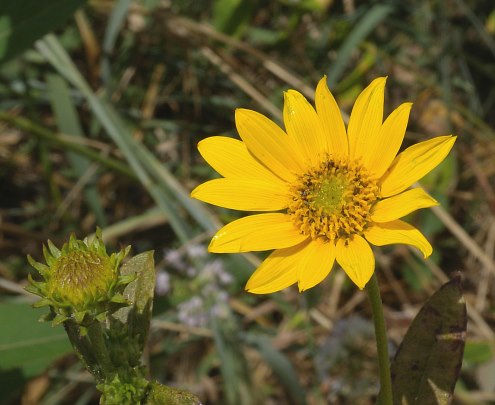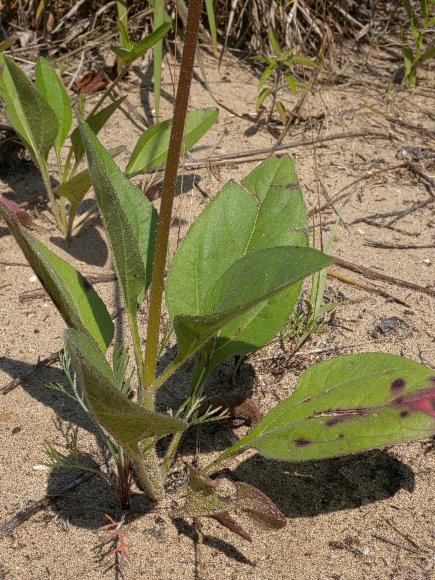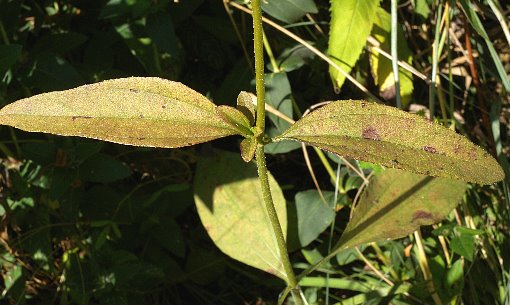
The flowering stalk terminates in 1-12 flowerheads that are usually arranged in a panicle. The peduncles of these flowerheads are ½-6" long. Individual flowerheads are 1½-2½" across, consisting of 8-22 ray florets that surround numerous disk florets. The petaloid rays are yellow and oblong to elliptic in shape. The tiny disk florets have tubular corollas that are yellow and 5-lobed. Around the base of each flowerhead, there are several overlapping phyllaries (floral bracts). These phyllaries are 5-7 mm. long, light green, linear-lanceolate in shape, and ciliate along their margins. The blooming period occurs from mid-summer to early fall, lasting about 1 month for a colony of plants. Afterwards, the fertile disk florets are replaced by achenes about 3-4 mm. in length. These achenes are broadly oblongoid and somewhat flattened in shape; they have a pair of scale-like awns that are early-deciduous. The root system consists of a narrow taproot with shallow rhizomes. Vegetative colonies of plants are sometimes produced from these rhizomes.
Cultivation: The preference is full sun, mesic to dry conditions, and sandy soil. This wildflower will also adapt to partial sun and rocky soil. On deep fertile soil, it is not competitive with other species of plants. This is one of the less aggressive Helianthus spp. (sunflowers).
Range & Habitat: The native Western Sunflower is occasional in the northern half of Illinois, while in the southern section of the state it is uncommon or absent. Habitats include upland sand prairies, sandy hill prairies, upland sandy savannas, limestone and sandstone glades, sandy areas along railroads, and sandy abandoned fields. This sunflower is usually found in higher quality habitats where the original ground flora is still intact.
Faunal Associations: The pollinators of Western Sunflower are probably similar to those of other sunflowers that grow in relatively open areas. This includes such insects and long-tongued bees, short-tongued bees, miscellaneous flies, and occasional butterflies. The following bees are oligoleges (specialist pollinators) of sunflowers (Helianthus spp.): Dufourea marginata, Andrena accepta, Andrena helianthi, Andrena aliciae, Melissodes agilis, and Pseudopanurgus rugosus. Other insects feed on the foliage, bore through the stems, feed on the florets and seeds, or suck plant juices from sunflowers. These species include: the leafhoppers Mesamia straminea and Mesamia nigridorsum, the aphids Uroleucon illini and Uroleucon helianthicola, the plant bugs Ilnacora stalii and Ilnacora malina, Haplorhynchites aeneus (Sunflower Head-Clipping Weevil) and Cylindrocopturus adspersus (Sunflower Stem Weevil), the leaf beetles Physonota helianthi and Trirhabda adela, Contarinia schulzi (Sunflower Midge) and Neotephritis finalis (Sunflower Seed Maggot), Melanoplus packardii (Packard's Grasshopper) and Sparagemon collare (Mottled Sand Grasshopper), and the flower thrips Heterothrips auranticornis (see Insect Table for a more complete listing of these species). In addition to these insects, the larvae of such butterflies as Chlosyne gorgone (Gorgone Checkerspot), Chlosyne nycteis (Silvery Checkerspot), and Vanessa cardui (Painted Lady) feed on sunflowers, as do the larvae of Papaipema necopina (Sunflower Borer Moth), Suleima helianthana (Sunflower Bud Moth), and other moths.

The seeds of wild sunflowers are a nutritious source of food for many birds, including the Mourning Dove, Eastern Goldfinch, White-Winged Crossbill, Bobwhite Quail, American Crow, and several species of sparrows (see Bird Table). The seeds are also eaten by the Thirteen-Lined Ground Squirrel, mice, and voles. White-Tailed Deer and other hoofed mammalian herbivores browse on the flowering stalks and leaves of sunflowers. Because the Plains Pocket Gopher prefers many of the same habitats as the Western Sunflower in Illinois (open sandy habitats that are well-drained), it likely feeds on the roots, foliage, and seeds of this sunflower in some areas of the state.
Photographic Location: A flower garden in Urbana, Illinois, and a sandy area along a path at the Illinois Beach State Park in Illinois.

Comments: Because of its prominent basal leaves and nearly naked flowering stalks, the Western Sunflower has a very distinct appearance among Helianthus spp. (sunflowers). It resembles a petite Silphium terebinthinaceum (Prairie Dock), however the seeds of this latter wildflower are produced by the ray florets, rather than the disk florets. Also, the basal leaves of this latter wildflower are more toothed along their margins, more erect, and much larger in size. In spite of its distinct appearance, the Western Sunflower can form both natural and artificial hybrids with several species of sunflowers. One of these hybrids, Helianthus × cinereus, has Helianthus mollis (Downy Sunflower) as the other parent. The common name of this species, Western Sunflower, is somewhat misleading, because it isn't native to the western United States. Instead, its distribution is centered in the upper Midwest.